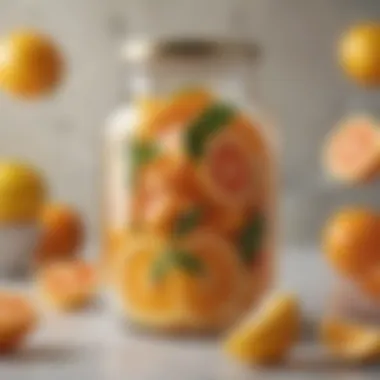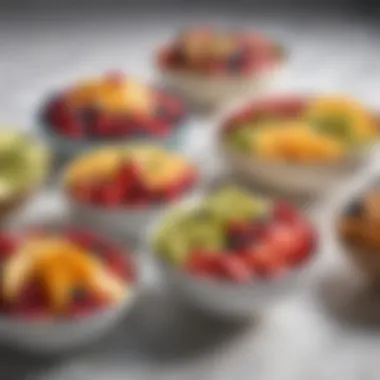Mastering Alcohol Infused Fruit: A Culinary Guide


Intro
Alcohol infused fruit represents a fascinating intersection of culinary artistry and scientific exploration, where flavor and aroma converge to create unique gastronomic experiences. The allure of this practice lies not only in the diverse and exciting flavors that can be achieved but also in the creativity it fosters among cooks and mixologists alike. This article will guide you through the various aspects of infusing fruit with alcohol, ensuring both novices and seasoned cooks find value in the insights presented.
The process involves steeping fruit in various liquors or spirits, allowing them to absorb and transform the alcohol's characteristics. The potential for experimentation is vast, making it possible to tailor concoctions to individual tastes or culinary themes. From appetizers to desserts, the applications of alcohol-infused fruit are as limitless as one’s imagination.
By understanding essential preparation techniques, flavor profiles, and even safety considerations, you can confidently venture into this intriguing world. Whether you are aiming to elevate your cocktails or create sophisticated compotes, this article will equip you with the necessary tools to succeed in your endeavors.
Prelude to Alcohol Infused Fruit
Alcohol infused fruit has gained popularity in modern culinary practices. This trend combines the natural sweetness and flavors of fresh fruits with various types of alcohol, creating unique taste experiences. Many enjoy this fusion for its ability to enhance flavor profiles in both beverages and dishes. It can transform simple ingredients into elevated delicacies, making it a valuable skill in the kitchen.
Definition and Concept
Alcohol infused fruit refers to the process of soaking fresh fruits in alcoholic beverages. Its primary objective is to infuse the fruit with the essence of the alcohol. The result is a delicious blend that can be savored on its own, added to cocktails, or incorporated into desserts. This technique not only enhances the taste but also introduces complexity to each dish. The type of alcohol used can significantly affect the final flavor, providing a vast playground for culinary exploration.
Historical Background
The tradition of alcohol infusion is not new. Historical records show that various cultures have employed similar practices for centuries. Infusing fruits with alcohol can be traced back to ancient civilizations. For example, the Romans were known to mix wine with fruits during feasts. In more recent history, flavored spirits and fruit liqueurs became common in Europe, showcasing this blending art. Today, the craft has evolved, with innumerable recipes and techniques available to enthusiasts. Understanding this historical context allows cooks to appreciate the depth and richness of alcohol infused fruit.
Types of Alcohol Used
The selection of alcohol for infusion is crucial in achieving the desired flavor profile in your fruit creations. Each type of alcohol contributes unique attributes, impacting taste, aroma, and overall experience. Understanding the characteristics of various alcoholic beverages allows for intentional choices that enhance the final product. The process of infusion captures the distinctive essence of the alcohol and melds it with the natural sweetness and acidity of the fruit. This section will explore three main categories of alcohol commonly used in infusion: spirits and liqueurs, wines and champagnes, and beers and ciders. Each brings a different richness and complexity to fruit.
Spirits and Liqueurs
Spirits such as vodka, rum, gin, and whiskey form the backbone of many infused fruit recipes. Their higher alcohol content allows for efficient extraction of flavors from the fruit. Vodka, known for its neutrality, permits the natural flavors of the fruit to shine through. Rum, with its caramel and vanilla notes, can add a depth of sweetness, making it ideal for tropical fruits like pineapple or mango.
Liqueurs, on the other hand, are typically sweeter and often infused with additional flavors, such as herbs or spices. An example is Amaretto, which pairs exceptionally well with pears. When using spirits, one consideration is the balance of alcohol strength. Fruit with a robust flavor can handle stronger spirits, whereas delicate fruits like berries may fare better with lighter, more neutral options.
Wines and Champagnes
Wines and champagnes offer a different set of attributes in infusion. They tend to have lower alcohol content, resulting in a more subtle impact on the fruit. Using white wines, such as Sauvignon Blanc, can yield refreshing results, ideal for citrus or stone fruits. Red wines, like Merlot or Cabernet Sauvignon, impart a rich and bold flavor, particularly suited for darker fruits such as cherries and plums.
Champagnes and sparkling wines introduce effervescence and acidity, enhancing the freshness of the fruit. They can elevate any dessert or appetizer. The main consideration when choosing wine is the overall harmony of flavor. The sweetness or dryness should correspond well to the fruit's profile to avoid overpowering the natural taste.
Beers and Ciders
Beers and ciders might seem unconventional, but they bring distinct advantages when it comes to fruit infusion. Lighter ales and lagers, with their crisp profiles, can inject a refreshing twist into citrus fruits or melons. Some darker beers, like porters or stouts, can complement richer flavors such as peaches or apricots with their roasted notes.
Ciders, on the other hand, are a perfect match for many fruits due to their fruity base. The sweetness of apple cider can blend harmoniously with a variety of fruits like raspberries and strawberries.
"The beauty of alcohol infusion lies in the ability to craft a recipe that feels personal and vibrant, tailoring the flavors to suit your palate."
Choose wisely and enjoy the process of experimentation.
Choosing the Right Fruits
Choosing the right fruits is crucial in the craft of alcohol infused fruit. The character of the infusion is greatly influenced by the fruit selected. Each fruit has its unique flavor, texture, and sweetness that can either complement or clash with the selected alcohol. This consideration shapes the final outcome, enhancing not only the aesthetics of the dish but also its taste.
The benefits of carefully selecting fruits extend beyond taste. Fresh, seasonal fruits are usually more flavorful and have a better texture, which contributes to the infusion process. A thoughtful approach to choosing fruits can also affect the alcohol's interaction with the sugars and acids present, allowing for a more intricate taste profile in the finished product. Hence, understanding seasonal trends can aid in selecting ingredients that are both vibrant and ripe.
Seasonal Considerations
When it comes to selecting fruits for infusion, seasonal availability is a prime factor. Different fruits peak at various times of the year, and using them in their prime can make a significant difference in the quality of the final product. For instance, berries like strawberries and blueberries are best during the summer months, offering robust flavors that can enhance spirits.
The concept of seasonality also ties into sustainability practices. Choosing fruits that are in season generally reduces environmental impact, as they do not require long-distance transportation or extensive greenhouse cultivation. Some notable seasonal fruits to consider include:


- Spring: Strawberries, rhubarb, and cherries.
- Summer: Peaches, plums, and melons.
- Fall: Apples, pears, and cranberries.
- Winter: Citrus fruits like oranges, lemons, and grapefruits.
By recognizing these seasons, you can harness the best flavor profiles available.
Flavor Profiles and Pairing
Flavor profiles of fruits play an integral role in achieving a harmonious infusion. Each fruit brings a distinct taste that interacts uniquely with different types of alcohol. For example, citrus fruits impart brightness, while stone fruits provide a rich flavor that can blend smoothly with spirits like whiskey and rum.
Consider these pairings:
- Berries with Gin: The tartness of berries can brighten the botanicals of gin, creating a refreshing infusion.
- Peaches with Bourbon: Sweet peaches can enhance the caramel and oak notes of bourbon, leading to a well-rounded experience.
- Citrus with Vodka: Citrus fruits can lend zesty notes, creating a clean, vibrant infusion that highlights the neutrality of vodka.
It’s important to experiment carefully. While some combinations are known to be successful, others may yield unexpected results. Documenting these attempts will help refine your palate, guiding future creations.
"The artistry of a great infusion lies in balancing flavors, selecting fruits that complement, rather than overpower. Continuous experimentation leads to mastery."
Methods of Infusion
The Methods of Infusion are crucial when it comes to crafting alcohol infused fruit. Each method offers its own unique advantages and results in distinct flavor profiles. Understanding these methods helps both novices and experienced cooks achieve the desired intensity and taste in their infused creations. Furthermore, the choice of infusion method can affect the texture, aroma, and overall appeal of the final dish. Choosing the right technique is essential to elevate the culinary experience and fully harness the interplay between fruit and alcohol.
Cold Infusion Techniques
Cold infusion techniques are often favored for their simplicity and effectiveness. This method allows the natural flavors of the fruit to meld with the alcohol without applying heat. A common approach is to submerge the chosen fruit in a jar with alcohol, then refrigerate it for an extended period. The result is a refreshing and aromatic infusion.
When using this technique, consider the following:
- Time Frame: Infusion typically requires a minimum of 24 hours, but longer periods often yield best results. Depending on the fruit and alcohol, it can take several days or even weeks for the flavors to fully develop.
- Fruit Choices: Certain fruits, like strawberries or peaches, infuse particularly well in a cold environment, retaining their crispness while adopting the alcoholic notes.
- Alcohol Selection: Choose spirits or liqueurs that complement the fruit's profile. For instance, vodka may be used for a neutral taste, while rum can add sweetness.
Heat Infusion Techniques
Heat infusion techniques apply warmth to enhance flavor extraction. This method is effective for rapidly incorporating intense flavors and can work well with fruits that have tougher skins or denser flesh. By gently heating the fruit with alcohol, the flavors are released more quickly.
Key points to consider include:
- Temperature Control: It’s crucial to avoid boiling the mixture, as high temperatures can alter the alcohol and the delicate fruit flavors. Instead, a low simmer is preferred.
- Process Duration: This technique typically requires less time than cold infusion, often taking around 15 to 30 minutes to achieve the desired result.
- Applications: Heat infusion is suitable for making syrups or sauces that incorporate infused flavors, enhancing both sweet and savory dishes.
Rapid Infusion Methods
Rapid infusion methods employ technology or specific techniques to achieve quick results. These methods can significantly reduce the time needed for infusion while maximizing flavor extraction. One popular approach involves using a vacuum chamber or whip siphon to accelerate the process.
Here are some factors of note:
- Vacuum Technique: By placing fruit and alcohol in a vacuum, the pressure is reduced, allowing the alcohol to penetrate the fruit quickly. This can result in a deeper flavor in a matter of minutes.
- Commercial Equipment: Tools like whipping siphons can infuse flavors rapidly by forcing gas into the mixture, creating a high-pressure environment that is ideal for infusing.
- Experimentation: These methods provide an opportunity for creativity. Experiment with various fruits and alcohol combinations to discover new taste profiles.
"Choosing the right infusion method can elevate your culinary creations, allowing the natural flavors to shine alongside the characteristics of the added alcohol."
In summary, understanding the various methods of infusion can transform the way alcohol infused fruit is approached. Each method introduces unique characteristics to the final product and will cater to different preferences and culinary goals.
Safety Considerations
Safety is an essential aspect when it comes to preparing alcohol infused fruit. As appealing as the fusion of flavors may be, it is vital to ensure that the process is safe for consumption. This section details the key elements that one should consider to enjoy this culinary adventure without compromising health or wellbeing.
Alcohol Content and Consumption
Understanding the alcohol content in infused fruit is crucial. Infusion methods can drastically change the strength of the alcohol in the final product. A common mistake is to underestimate how much alcohol is absorbed by the fruit. For example, fruits like strawberries or watermelon can soak up a considerable amount of alcohol, elevating their potency.
When planning to serve alcohol infused fruit, consider the following:
- Calculate proper servings: It is important to know the volume of alcohol used and the number of servings. This ensures guests are not consuming too much without realizing it.
- Educate about alcohol content: Make sure to inform anyone who will consume the infused fruits about their potential strength. Confusion may lead to unexpected effects, especially for those who may be sensitive to alcohol.
- Monitor consumption: If serving at a gathering, keep tabs on how much is enjoyed. This approach helps in ensuring everyone remains safe and responsible while indulging.


Storage and Shelf Life
Storage methods for alcohol infused fruit significantly impact their quality and safety. This consideration includes how long the fruit can remain edible and safe after infusion.
- Refrigeration: Always refrigerate alcohol infused fruits. They can spoil quickly, especially when mixed with fresh fruits. Keeping them chilled will help prolong their freshness and prevent bacterial growth.
- Shelf life: Typically, infused fruits can last up to a week in the refrigerator. However, the exact time frame can vary based on the type of fruit and the alcohol used. Softer fruits may spoil quicker, while firmer ones have a longer shelf life.
- Visual checks: Prior to serving, always check for any signs of spoilage such as discoloration, off-smells, or mold. These indicators tell whether the fruit is still safe to consume.
Always prioritize health when enjoying alcohol infused fruit. A simple awareness of alcohol content and proper storage practices can help promote a safe culinary experience.
Culinary Applications
Culinary applications of alcohol infused fruit serve to broaden the scope of flavors in numerous dishes and drinks. This fusion allows chefs and home cooks to explore new taste profiles, enhancing both the presentation and flavor of meals. The integration of alcohol not only adds richness but also marries the natural sweetness and acidity of fruits with the complex notes of various spirits, wines, or beers. This section will discuss how liquor can revolutionize cocktails, desserts, and savory dishes.
Cocktails and Mixed Drinks
Alcohol infused fruit plays a crucial role in modern mixology. Infused fruits are often used in cocktails for flavor enhancement as they lend an intense depth that is hard to achieve through conventional mixing. Common practice involves using fruits like strawberries, peaches, and citrus that absorb alcohol while maintaining their structure. You might use vodka infused watermelon for a refreshing summer cocktail, or a peach bourbon infusion for a sweet yet robust drink.
Some benefits of using infused fruit in cocktails include:
- Flavor Diversity: Different fruits can change the cocktail's flavor profile significantly, offering unique experiences.
- Visual Appeal: Infused fruits can elevate the presentation of cocktails, making them more enticing.
- Versatility: Infused fruit can be utilized in various drinks, from classic martinis to tropical punches.
Desserts and Baking
The use of alcohol infused fruit in desserts opens up a new realm of culinary possibilities. When incorporated into desserts, these fruits add moisture and flavor complexity. Items like tarts, cakes, or even sorbets benefit greatly from infused fruits. For instance, consider a raspberry limoncello cake where the acidity from the limoncello perfectly complements the berries.
Key aspects to consider when using fruit in baking are:
- Balancing Flavors: The sweetness of the fruit must balance with the flavors of the alcohol.
- Cooking Time: Infused fruits should be incorporated at the right stage to avoid losing their integrity.
- Presentation: Infused fruits can be used as a decorative touch, such as on top of a cheesecake or within a trifle.
Savory Dishes
Incorporating alcohol infused fruit in savory dishes is a creative way to enhance flavors. Dishes like grilled chicken with orange-infused rum sauce or a salad featuring pickled peaches can create a unique culinary experience. The tangy sweetness from the fruit can balance the richness of certain proteins, making the dish more harmonious.
Considerations when using infused fruit in savory applications include:
- Complementing Ingredients: It is vital to select fruits that will complement the main ingredients rather than overpower them.
- Cooking Methods: Infused fruits can be grilled, sautéed, or used fresh, depending on the desired outcome.
- Cultural Influences: Different cultures utilize fruits and spirits in their cooking, allowing for a rich blend of techniques and tastes.
Alcohol infused fruit is a bridge between traditional flavors and innovative cooking, offering endless avenues for exploration and creativity.
As we analyze the culinary applications of alcohol infused fruits, it becomes apparent that they present opportunities for novel and distinctive dishes. From vibrant cocktails to decadent desserts and savory creations, the potential is vast.
DIY Alcohol Infused Fruit Recipes
Creating your own alcohol infused fruit can be one of the most rewarding culinary experiences. Not only does it allow for personalization of tastes, but it also gives home cooks the ability to explore different flavor profiles. By infusing fruits with alcohol, you can elevate any dish or drink, transforming ordinary ingredients into something exceptional. This section covers essential recipes and techniques, inviting readers to embark on their own infusion journey.
Classic Fruit Infusions
Classic fruit infusions are the cornerstone of any alcohol fruit enthusiast's repertoire. These recipes often include well-loved combinations that never go out of style. To start, consider the popular pairings of strawberries and vodka or peaches infused with bourbon. These combinations offer a balanced blend, enhancing the natural sweetness of the fruits while adding depth with alcohol.
Here are some classic fruit infusions to try:
- Strawberry Vodka Infusion:
Ingredients: Fresh strawberries, vodka.
Process: Slice strawberries and immerse them in vodka for at least 24 hours. The longer they soak, the more intense the flavor. - Peach Bourbon Infusion:
Ingredients: Ripe peaches, bourbon.
Process: Cut peaches into chunks and mix with bourbon. Let it steep in a cool place for 48 hours. Strain before use. - Lemon Gin Infusion:
Ingredients: Lemons, gin.
Process: Peel and chop the lemons. Combine with gin in a sealed jar for at least a week. The zest brings out a bright flavor.
These classic recipes serve as a foundation. They not only highlight the freshness of fruits but also showcase the versatility of spirits.
Innovative Flavor Combos
For those looking to push boundaries, innovative flavor combinations can transform the concept of alcohol infused fruit. These creative recipes blend less traditional fruits and spirits, resulting in unique culinary experiences. Experimenting with unexpected pairings can yield delightful surprises that impress and intrigue.


Consider these innovative infusions:
- Pineapple Rum and Jalapeno Infusion:
This combination offers a tropical burst of sweetness paired with a hint of heat. The gradual infusion of jalapeno enhances the rum, providing a spicy note. - Mango Tequila with Chili Powder:
Mango's sweetness coupled with tequila creates a tropical getaway. Adding a sprinkle of chili powder gives it a kick, perfect for adventurous palettes. - Blackberry Absinthe Infusion:
Blackberries add a beautiful color and flavor when infused with absinthe. The aromatic notes of absinthe complement the berries well.
Each innovative combination allows for exploration. Feel free to adjust ingredients based on availability and personal preference. These creative endeavors can lead to discovering new favorite flavors that redefine your approach to alcohol infused fruit.
Exploring these DIY recipes can help you find your signature flavors, whether classic or bold.
By developing classic and innovative recipes, one can appreciate the art of alcohol infused fruit. From the initial idea to the final tasting, every step is an opportunity for exploration and expression.
The Impact of Alcohol Infused Fruit on Modern Cuisine
Alcohol infused fruit represents a unique intersection of flavor and presentation in contemporary gastronomy. Its importance stems not only from the transforming nature of infusion processes but also the broader cultural and culinary implications it carries. As food enthusiasts increasingly seek innovative ways to enhance taste and experience, the incorporation of alcohol into fruit dishes has become a subject of significant interest.
One key aspect is the versatility of flavors. Different types of alcohol can create diverse taste profiles when combined with various fruits. For example, whiskey pairs well with peaches, while vodka complements the crispness of watermelon. This versatility has made alcohol infused fruit a staple in many culinary explorations, from elegant desserts to exciting cocktail recipes. It invites creativity and experimentation in the kitchen, allowing chefs and home cooks alike to push the boundaries of tradition.
"The exploration of flavor is essential in today’s culinary landscape, and alcohol infused fruit signifies a harmonious blend of innovation and classic techniques."
Beyond flavor, the visual presentation of alcohol infused fruit also plays a role in its appeal. Infusion adds a rich color and an enticing gloss to the fruit, often making dishes or drinks more attractive. This aspect is particularly important in food photography and social media, where presentation can significantly elevate a dish’s desirability and shareability.
Culinary trends have shown a rise in the use of alcohol anywhere from craft cocktails to gourmet desserts. Additionally, the health-conscious approach prevalent today cannot be ignored. Infusing fruit with alcohol can also serve to create lighter, flavorful options compared to traditional desserts, appealing to consumers who look for sophisticated yet approachable indulgences.
In sum, the impact of alcohol infused fruit on modern cuisine cannot be overstated. It symbolizes a shift toward more adventurous dining experiences and reflects the evolving tastes of consumers. The development of infusion techniques meets the demand for unique flavors and visually appealing presentations, making it a relevant and important topic in contemporary culinary discussions.
Current Trends in Infusion
In recent years, there has been a marked increase in the popularity of alcohol infused fruit. Current trends indicate a strong preference for craft cocktails that feature seasonal and locally sourced fruits. Bars and restaurants are embracing the art of infusion to create signature drinks that stand out.
Moreover, the rise of DIY infusion methods at home has become significant. Enthusiastic cooks share their recipes and techniques on platforms like Reddit and Facebook, encouraging a sense of community. Social media has acted as a catalyst for this trend, with beautiful pictures of infused fruits and drinks going viral. This visibility inspires more people to explore their creativity in the kitchen. Some noteworthy trends include:
- Signature Infusions: Many cocktail bars now develop unique infusions that define their beverage menus, often featuring house-made fruit and spirit blends.
- Plant-Based Combinations: There is a growing interest in pairing fruit with botanical spirits or herbal liqueurs, emphasizing fresh flavors and natural ingredients.
- Sustainable Infusions: Chefs are more consciously selecting fruits that are in season or sourced from sustainable farms, reflecting the growing demand for eco-friendly culinary practices.
These trends showcase how alcohol infused fruit is not just a passing fad, but a substantial element of modern cuisine that continues to evolve with consumer preferences.
Cultural Perspectives
The practice of infusing fruit with alcohol carries cultural significance across various regions and traditions. Different cultures have their unique ways of incorporating infused fruits into their culinary repertoire. For instance, in some Mediterranean countries, fruit preserves are common and often involve alcohol, such as brandy or rum, enhancing the flavor profile while also preserving the fruit.
In contrast, Asian culinary traditions utilize similar techniques with different fruits and spirits, showcasing diverse methods of alcohol infusion. For example, sake can be used with peaches or plums to create refreshing summer drinks, while traditional Chinese desserts sometimes feature fruits combined with rice wine. This cultural exchange enriches the global palette and encourages culinary adventurism.
Understanding these perspectives helps deepen appreciation for the nuances of alcohol infused fruit. As chefs and home cooks draw inspiration from various traditions, they contribute to a more globalized culinary landscape. Thus, the art of alcohol infused fruit bridges cultures and invites dialogues about flavor, tradition, and innovation.
Epilogue
The exploration of alcohol infused fruit serves as a bridge between flavors and experiences. This section highlights the significance of mastering the craft of infusing fruits with alcohol, outlining how this creative process enhances not only the taste but also the visual appeal of dishes. Infusing fruits creates an inviting allure that can elevate both casual gatherings and formal events. The nuanced combination of fruit and alcohol brings forth complexities that can surprise and delight the palate.
In this article, we have dissected the methods, safety concerns, and culinary applications surrounding alcohol infused fruit. Understanding these elements is crucial for anyone wishing to dive into this rewarding culinary practice. It ensures that individuals can create infused fruits safely and deliciously. Moreover, the exploration of different alcoholic bases enriches the experience.
To effectively summarize the craft, it is essential to recognize that alcohol infused fruit is more than a mere trend. It embodies a fusion of tradition and innovation. Each infusion possess unique character and story. The impact extends through various cuisines, allowing for cultural exchange and culinary experimentation.
"Crafting alcohol infused fruit is a blend of art and science, intriguing food lovers and culinary scholars alike."
Therefore, by embracing this skill, one can produce distinct flavors that resonate with the modern culinary scene, making the practice both relevant and essential.
Summarizing the Craft
The craft of alcohol infusion involves a thorough understanding of flavor profiles, infusion methods, and safety parameters. Familiarity with these aspects leads to precise executions and delightful results. When fruits are infused, their natural sugars interact with the alcohol, creating a symphony of sweetness and richness. Each fruit behaves differently, and it's important to study each one's attributes, from the acidity of citrus to the subtle sweetness of berries.
A well-executed infusion showcases the art of balance. The right alcohol can enhance or detract from the essence of fruit. For instance, using a robust bourbon with peaches can create a rich dessert option, while vodka might serve to highlight the delicate nature of strawberries. In short, the craft is nuanced, requiring both finesse and creativity.
Encouraging Experimentation
To truly excel in the domain of alcohol infused fruits, one must adopt an experimental mindset. Many successful recipes stem from a willingness to try unconventional combinations and techniques. Consider pairing unexpected flavor notes, such as spicy rum with piquant mango, or a dry rosé with tart rhubarb for refreshing insights.
This experimentation can extend to various applications. Think beyond cocktails; consider incorporating infused fruits into your next savory dish, or use them in creative desserts. Embrace mistakes as learning opportunities, refining your approach as you go. Remember that experimentation is not just about making new recipes, but discovering new interests and flavors in the culinary arts.















